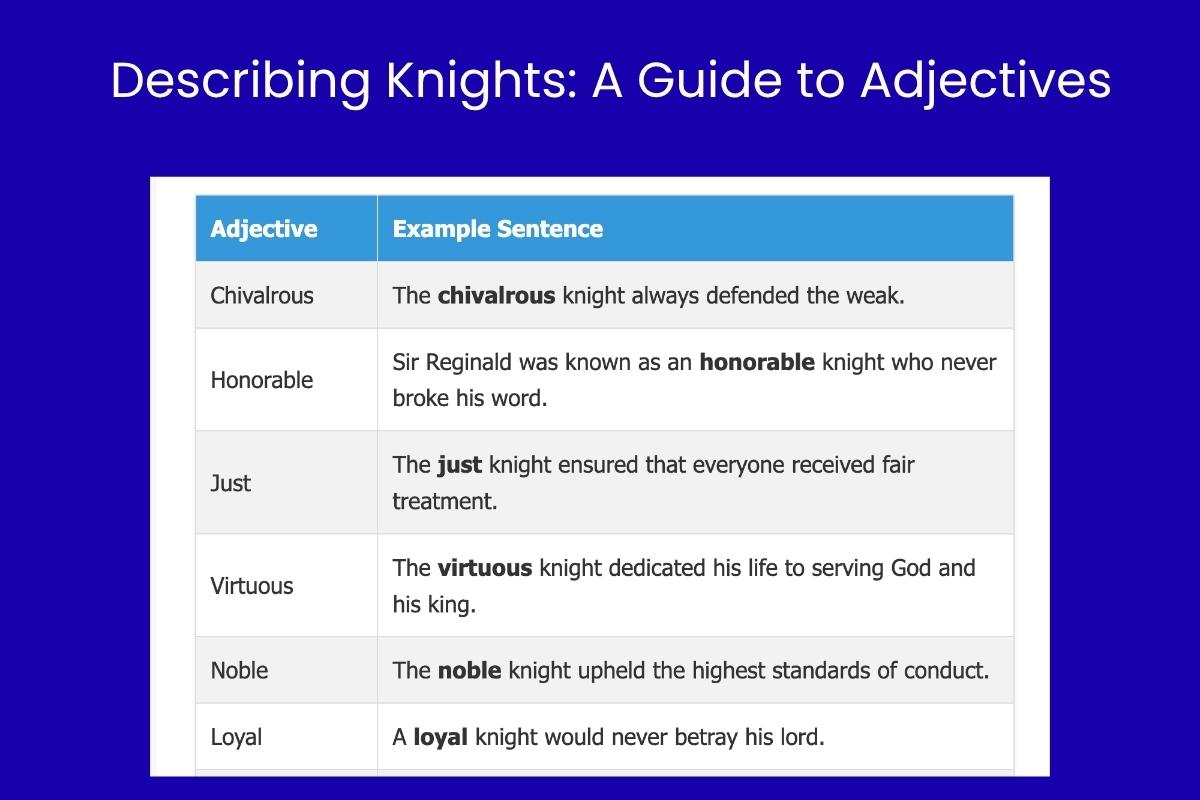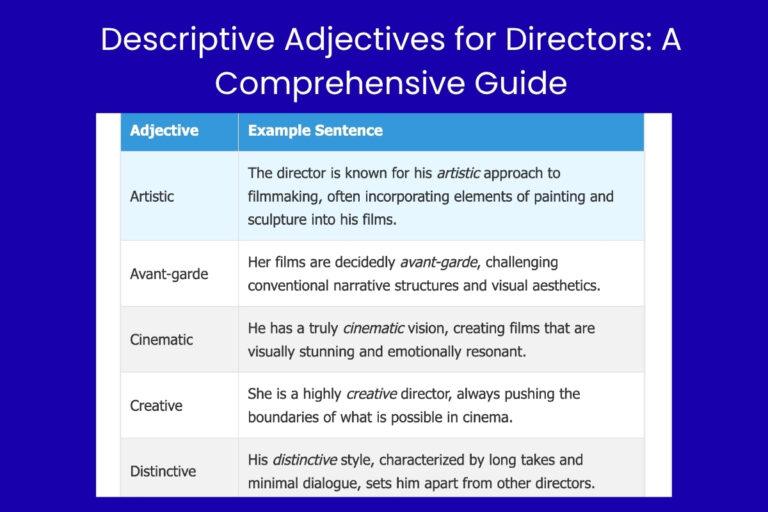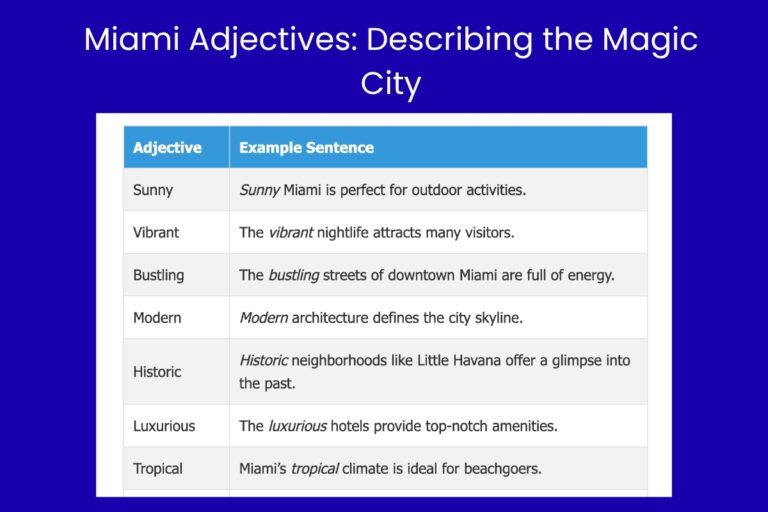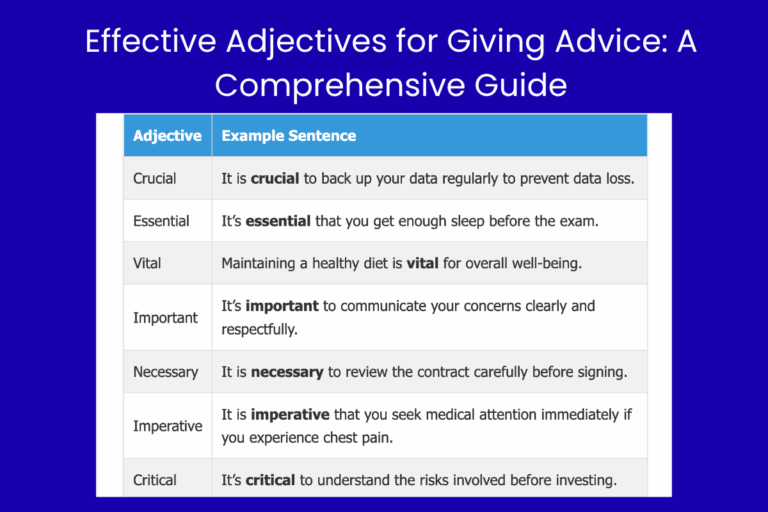Describing Knights: A Guide to Adjectives
Knights, symbols of chivalry, courage, and honor, have captivated imaginations for centuries. To effectively describe these figures in literature, history, or even creative writing, a rich vocabulary of adjectives is essential. This article provides a comprehensive guide to adjectives that can vividly portray knights, covering their virtues, armor, deeds, and more. Whether you’re a student, writer, or simply an enthusiast, this resource will enhance your ability to depict knights with accuracy and flair.
Understanding adjectives is crucial for any English language learner. They add depth and detail to our descriptions, making our writing more engaging and informative. This guide is designed for learners of all levels, from beginners seeking basic vocabulary to advanced speakers aiming to refine their descriptive skills.
Table of Contents
- Definition of Adjectives for Knights
- Structural Breakdown
- Types and Categories of Adjectives for Knights
- Examples of Adjectives for Knights
- Usage Rules for Adjectives Describing Knights
- Common Mistakes When Using Adjectives for Knights
- Practice Exercises
- Advanced Topics
- Frequently Asked Questions
- Conclusion
Definition of Adjectives for Knights
An adjective is a word that modifies a noun or pronoun, providing more information about it. When describing knights, adjectives help to paint a vivid picture of their character, appearance, equipment, and actions. These adjectives can range from simple descriptions like “brave” or “tall” to more evocative terms like “chivalrous” or “impenetrable.” The choice of adjectives significantly impacts how a knight is perceived by the audience, shaping their understanding of the knight’s role and significance.
Adjectives for knights serve to enhance the imagery and convey specific attributes. They allow writers and speakers to go beyond basic descriptions and delve into the nuanced qualities that define a knight. For instance, instead of simply stating “the knight fought,” using adjectives like “the valiant knight fought” provides a more compelling and descriptive narrative.
Structural Breakdown
Adjectives typically precede the noun they modify (e.g., “the noble knight”). However, they can also follow a linking verb such as “is,” “was,” “seems,” or “becomes” (e.g., “the knight was courageous“). Understanding the placement of adjectives is crucial for constructing grammatically correct and stylistically effective sentences.
Adjectives can also be modified by adverbs, which further refine their meaning. For example, instead of saying “the knight was brave,” one could say “the knight was exceptionally brave,” where “exceptionally” is the adverb modifying the adjective “brave.”
Furthermore, adjectives can be used comparatively and superlatively. Comparative adjectives compare two nouns (e.g., “Sir Lancelot was bolder than Sir Gawaine”), while superlative adjectives indicate the highest degree of a quality among three or more nouns (e.g., “Sir Galahad was the most virtuous knight”).
Types and Categories of Adjectives for Knights
Adjectives for knights can be categorized based on the aspects they describe. These categories include virtues, appearance, armor and equipment, deeds and actions, and personality traits.
Adjectives Describing Virtues
These adjectives highlight the moral and ethical qualities of a knight. They emphasize the knight’s adherence to the code of chivalry and their commitment to upholding justice and honor.
Adjectives Describing Appearance
These adjectives focus on the physical attributes of a knight, including their height, build, and overall appearance. They help to create a visual image of the knight in the reader’s mind.
Adjectives Describing Armor and Equipment
These adjectives describe the armor, weapons, and other equipment used by a knight. They provide details about the knight’s gear and its condition, contributing to the overall portrayal of the knight.
Adjectives Describing Deeds and Actions
These adjectives describe the actions and accomplishments of a knight, highlighting their bravery, skill, and effectiveness in battle or other endeavors. They showcase the knight’s capabilities and contributions.
Adjectives Describing Personality Traits
These adjectives describe the inner qualities and characteristics of a knight, such as their temperament, disposition, and personal attributes. They provide insight into the knight’s character and motivations.
Examples of Adjectives for Knights
The following sections provide extensive examples of adjectives categorized by the aspects of knights they describe.
Examples Describing Virtues
These examples illustrate adjectives that describe the moral and ethical qualities of knights. These adjectives are crucial for portraying knights as paragons of virtue and honor.
The table below presents a wide array of adjectives that describe the virtues of a knight. Each adjective is paired with a sentence illustrating its use.
| Adjective | Example Sentence |
|---|---|
| Chivalrous | The chivalrous knight always defended the weak. |
| Honorable | Sir Reginald was known as an honorable knight who never broke his word. |
| Just | The just knight ensured that everyone received fair treatment. |
| Virtuous | The virtuous knight dedicated his life to serving God and his king. |
| Noble | The noble knight upheld the highest standards of conduct. |
| Loyal | A loyal knight would never betray his lord. |
| Courteous | The courteous knight treated everyone with respect. |
| Generous | The generous knight shared his wealth with the poor. |
| Merciful | The merciful knight spared the lives of his defeated enemies. |
| Pious | The pious knight spent hours in prayer each day. |
| Valiant | The valiant knight charged fearlessly into battle. |
| Benevolent | The benevolent knight sought to improve the lives of his people. |
| Righteous | The righteous knight always stood up for what was right. |
| Upright | An upright knight was a model of integrity. |
| Principled | The principled knight refused to compromise his values. |
| Gallant | The gallant knight rescued the damsel in distress. |
| Gracious | The gracious knight accepted the surrender with dignity. |
| Temperate | A temperate knight avoided excess in all things. |
| Faithful | The faithful knight remained true to his oath. |
| Honest | The honest knight always spoke the truth. |
| Magnanimous | The magnanimous knight forgave his rivals. |
| Selfless | The selfless knight put others before himself. |
| Truthful | The truthful knight was respected by all. |
| Kind | The kind knight offered assistance to those in need. |
| Compassionate | The compassionate knight understood the suffering of others. |
Examples Describing Appearance
These adjectives provide details about the physical attributes of knights, helping to create a vivid image of their appearance. These descriptions can enhance the reader’s understanding and engagement with the character.
The table below contains adjectives that describe the appearance of a knight. Each adjective is accompanied by a sentence demonstrating its usage.
| Adjective | Example Sentence |
|---|---|
| Tall | The tall knight towered over his opponents. |
| Muscular | His muscular frame suggested great strength. |
| Handsome | The handsome knight was admired by many. |
| Stout | The stout knight was known for his resilience. |
| Lean | The lean knight was swift and agile. |
| Well-built | The well-built knight was a formidable warrior. |
| Rugged | His rugged features spoke of many battles. |
| Youthful | The youthful knight was eager to prove himself. |
| Weathered | His weathered face told stories of long campaigns. |
| Imposing | The imposing knight commanded respect. |
| Striking | The striking knight was easily recognizable. |
| Dashing | The dashing knight charmed the ladies with his wit and appearance. |
| Broad-shouldered | The broad-shouldered knight looked strong and capable. |
| Stern | The stern knight rarely smiled. |
| Pale | The pale knight had a haunted look. |
| Brunette | The brunette knight had dark, piercing eyes. |
| Blond | The blond knight was known for his fair hair. |
| Grey-haired | The grey-haired knight was a veteran of many wars. |
| Bearded | The bearded knight looked wise and experienced. |
| Clean-shaven | The clean-shaven knight had a more youthful appearance. |
| Scarred | The scarred knight bore the marks of countless battles. |
| Tattooed | The tattooed knight had intricate designs on his arms. |
| Elegant | The elegant knight moved with grace and poise. |
| Sturdy | The sturdy knight was built to withstand hardship. |
| Well-groomed | The well-groomed knight took pride in his appearance. |
Examples Describing Armor and Equipment
These adjectives describe the armor, weapons, and other equipment used by knights. They provide details about the knight’s gear and its condition, enhancing the realism and detail of the portrayal.
The table below lists adjectives that describe a knight’s armor and equipment. Each adjective is paired with a sentence illustrating its use.
| Adjective | Example Sentence |
|---|---|
| Polished | The polished armor gleamed in the sunlight. |
| Impenetrable | His impenetrable shield deflected every blow. |
| Ornate | The ornate helmet was decorated with gold. |
| Heavy | The heavy armor weighed him down, but protected him well. |
| Steel | The steel sword was razor sharp. |
| Shining | His shining armor reflected the light. |
| Damaged | The damaged shield bore the marks of many battles. |
| Engraved | The engraved sword was a family heirloom. |
| Gilded | The gilded armor was a symbol of his wealth and status. |
| Reinforced | The reinforced helmet offered extra protection. |
| Feathered | The feathered helmet added to his imposing stature. |
| Battle-worn | The battle-worn armor told a story of countless fights. |
| Well-maintained | His well-maintained equipment showed his attention to detail. |
| Sharp | The sharp lance was ready for the joust. |
| Reliable | His reliable steed carried him swiftly into battle. |
| Plated | The plated armor offered excellent defense. |
| Visored | The visored helmet protected his face. |
| Bulky | The bulky armor restricted his movements somewhat. |
| Lightweight | The lightweight armor allowed for greater agility. |
| Darkened | The darkened armor was designed for stealth. |
| Ceremonial | The ceremonial armor was worn only for special occasions. |
| Functional | The functional armor was designed for practicality. |
| Immaculate | The immaculate armor was kept in pristine condition. |
| Sturdy | The sturdy shield could withstand heavy blows. |
| Etched | The etched designs on the armor told a story. |
Examples Describing Deeds and Actions
These adjectives describe the actions and accomplishments of a knight, highlighting their bravery, skill, and effectiveness in battle or other endeavors. They showcase the knight’s capabilities and contributions.
The table below contains adjectives that describe the deeds and actions of a knight. Each adjective is accompanied by a sentence demonstrating its usage.
| Adjective | Example Sentence |
|---|---|
| Brave | The brave knight faced the dragon without fear. |
| Heroic | His heroic deeds were celebrated throughout the kingdom. |
| Daring | The daring knight accepted the perilous quest. |
| Courageous | The courageous knight defended the castle against invaders. |
| Valiant | The valiant knight charged into the fray. |
| Fearless | The fearless knight knew no bounds. |
| Bold | The bold knight challenged the tyrant to a duel. |
| Skilled | The skilled knight was a master swordsman. |
| Victorious | The victorious knight returned home a hero. |
| Successful | The successful knight completed his mission. |
| Resolute | The resolute knight never gave up, even in the face of adversity. |
| Determined | The determined knight trained tirelessly to improve his skills. |
| Strategic | The strategic knight planned his attacks carefully. |
| Tactical | His tactical maneuvers won many battles. |
| Decisive | The decisive knight made quick and effective decisions. |
| Accomplished | The accomplished knight had a long list of achievements. |
| Renowned | The renowned knight was famous throughout the land. |
| Illustrious | His illustrious career was marked by many victories. |
| Celebrated | The celebrated knight was honored at court. |
| Legendary | The legendary knight’s tales were told for generations. |
| Triumphant | The triumphant knight returned with spoils of war. |
| Gallant | The gallant knight rescued the princess from the tower. |
| Audacious | The audacious knight attempted the impossible. |
| Vigilant | The vigilant knight kept watch over the kingdom. |
| Persevering | The persevering knight overcame every obstacle. |
Examples Describing Personality Traits
These adjectives describe the inner qualities and characteristics of a knight, such as their temperament, disposition, and personal attributes. They provide insight into the knight’s character and motivations.
The table below provides adjectives that describe a knight’s personality traits. Each adjective is accompanied by a sentence demonstrating its usage.
| Adjective | Example Sentence |
|---|---|
| Humble | The humble knight never boasted of his accomplishments. |
| Wise | The wise knight offered valuable counsel to the king. |
| Patient | The patient knight waited for the right moment to strike. |
| Kind | The kind knight showed compassion to all. |
| Gentle | The gentle knight treated everyone with respect. |
| Stern | The stern knight demanded discipline and obedience. |
| Reserved | The reserved knight kept his thoughts to himself. |
| Stoic | The stoic knight endured hardship without complaint. |
| Intelligent | The intelligent knight was a skilled strategist. |
| Observant | The observant knight noticed every detail. |
| Gregarious | The gregarious knight enjoyed the company of others. |
| Solitary | The solitary knight preferred his own company. |
| Calm | The calm knight remained cool under pressure. |
| Impulsive | The impulsive knight acted without thinking. |
| Disciplined | The disciplined knight followed a strict code of conduct. |
| Ambitious | The ambitious knight sought to rise through the ranks. |
| Modest | The modest knight downplayed his own achievements. |
| Pensive | The pensive knight spent much time in thought. |
| Witty | The witty knight entertained the court with his humor. |
| Serious | The serious knight took his responsibilities to heart. |
| Empathetic | The empathetic knight understood the feelings of others. |
| Cynical | The cynical knight questioned the motives of everyone. |
| Optimistic | The optimistic knight always looked on the bright side. |
| Pessimistic | The pessimistic knight expected the worst. |
| Idealistic | The idealistic knight believed in a better world. |
Usage Rules for Adjectives Describing Knights
When using adjectives to describe knights, it’s important to follow standard English grammar rules. Adjectives usually precede the noun they modify, but they can also follow linking verbs. Pay attention to the order of adjectives when using multiple adjectives to describe a knight; general opinions typically come before specific details.
For example, “the brave, tall knight” is grammatically correct, while “the tall brave knight” might sound less natural, depending on the context. Also, be mindful of using the correct form of adjectives (comparative and superlative) when comparing knights.
Example:
- Correct: Sir Lancelot was a more skilled knight than many others.
- Incorrect: Sir Lancelot was a skilleder knight than many others.
Common Mistakes When Using Adjectives for Knights
One common mistake is using adjectives that don’t accurately reflect the qualities typically associated with knights. For instance, describing a knight as “cowardly” would be contradictory to the traditional image of a knight.
Another mistake is using adjectives redundantly. For example, “the brave and courageous knight” is redundant because “brave” and “courageous” have similar meanings. Choose adjectives that provide distinct and meaningful descriptions.
Examples:
- Incorrect: The cowardly knight charged into battle.
- Correct: The brave knight charged into battle.
- Incorrect: The brave and courageous knight defended the realm.
- Correct: The brave knight defended the realm.
Practice Exercises
Test your understanding of adjectives for knights with the following exercises.
Exercise 1: Fill in the blanks with appropriate adjectives from the list provided.
List of Adjectives: chivalrous, valiant, imposing, loyal, skilled, honorable, just, courageous, noble, wise
| Question | Answer |
|---|---|
| 1. The _______ knight always treated ladies with respect. | chivalrous |
| 2. Sir Galahad was known as a _______ and _______ knight. | noble, honorable |
| 3. The _______ knight faced the dragon with unwavering resolve. | courageous |
| 4. The _______ knight served his king faithfully. | loyal |
| 5. The _______ knight was respected for his fairness. | just |
| 6. The _______ knight was a master swordsman. | skilled |
| 7. The _______ presence of the knight commanded attention. | imposing |
| 8. The _______ knight offered valuable advice to the king. | wise |
| 9. The _______ knight fought bravely in battle. | valiant |
| 10. An _______ knight always kept his word. | honorable |
Exercise 2: Rewrite the following sentences, adding adjectives to make them more descriptive.
| Question | Answer |
|---|---|
| 1. The knight rode into the forest. | The brave knight rode into the dark forest. |
| 2. The armor gleamed in the sun. | The polished armor gleamed in the bright sun. |
| 3. The sword was sharp. | The steel sword was razor sharp. |
| 4. The knight defended the castle. | The courageous knight defended the ancient castle. |
| 5. The battle was fierce. | The battle was fierce and bloody. |
| 6. The king rewarded the knight. | The king rewarded the loyal knight. |
| 7. The steed was fast. | The reliable steed was fast. |
| 8. The helmet protected the knight. | The visored helmet protected the knight. |
| 9. The shield deflected blows. | The sturdy shield deflected blows. |
| 10. The tale was told for generations. | The legendary tale was told for generations. |
Exercise 3: Choose the best adjective from the options provided to complete each sentence.
| Question | Options | Answer |
|---|---|---|
| 1. The _______ knight was known for his wisdom. | (a) foolish (b) wise (c) ignorant | (b) wise |
| 2. The _______ armor protected him from harm. | (a) fragile (b) impenetrable (c) weak | (b) impenetrable |
| 3. The _______ knight always kept his word. | (a) dishonest (b) honorable (c) deceitful | (b) honorable |
| 4. The _______ knight never showed fear. | (a) timid (b) courageous (c) cowardly | (b) courageous |
| 5. The _______ knight was respected by all. | (a) despised (b) admired (c) disliked | (b) admired |
| 6. The _______ lance was used in the joust. | (a) dull (b) sharp (c) blunt | (b) sharp |
| 7. The _______ knight treated everyone with kindness. | (a) cruel (b) kind (c) mean | (b) kind |
| 8. The _______ knight was always ready to defend the weak. | (a) apathetic (b) chivalrous (c) indifferent | (b) chivalrous |
| 9. The _______ knight’s tales were told for years. | (a) forgettable (b) legendary (c) unremarkable | (b) legendary |
| 10. The _______ knight remained true to his oath. | (a) unfaithful (b) faithful (c) treacherous | (b) faithful |
Advanced Topics
For advanced learners, exploring the nuances of figurative language, such as metaphors and similes, can enhance their descriptive abilities. Consider how adjectives can be used metaphorically to describe abstract qualities or compare a knight to other objects or concepts.
Example:
- “The knight’s resolve was as unbreakable as his shield.” (simile)
- “He was a towering figure of strength and honor.” (metaphor)
Also, delve into the historical context of the adjectives used to describe knights. Understanding the values and ideals of the medieval period can provide deeper insights into the significance of certain adjectives.
Frequently Asked Questions
Q1: What is the difference between an adjective and an adverb?
A: An adjective modifies a noun or pronoun, while an adverb modifies a verb, adjective, or another adverb. For example, “brave knight” (brave is an adjective) vs. “fought bravely” (bravely is an adverb).
Q2: Can I use multiple adjectives to describe a knight?
A: Yes, you can use multiple adjectives. Just be mindful of the order in which you place them. Generally, opinion adjectives come before fact adjectives (e.g., “the brave, tall knight”).
Q3: How do I choose the right adjective to describe a knight?
A: Consider the specific qualities you want to emphasize. Think about the knight’s virtues, appearance, equipment, actions, and personality traits. Choose adjectives that accurately and vividly portray those aspects.
Q4: What are some common mistakes to avoid when using adjectives for knights?
A: Avoid using adjectives that contradict the traditional image of a knight (e.g., “cowardly”). Also, avoid redundancy by choosing adjectives with distinct meanings.
Q5: How can I improve my vocabulary of adjectives for knights?
A: Read widely in literature that features knights, such as medieval romances, historical fiction, and fantasy novels. Pay attention to the adjectives used by authors and make note of new or interesting words.
Q6: Are there any adjectives that should be avoided when describing knights?
A: Adjectives that contradict the core values of knighthood, such as “dishonorable,” “treacherous,” or “cowardly,” should generally be avoided unless you are intentionally subverting the traditional portrayal of a knight.
Q7: How do comparative and superlative adjectives work when describing knights?
A: Comparative adjectives compare two knights (e.g., “Sir Lancelot was braver than Sir Kay”). Superlative adjectives indicate the highest degree of a quality among three or more knights (e.g., “Sir Galahad was the most virtuous knight of all”).
Q8: Can adjectives be used figuratively to describe knights?
A: Yes, adjectives can be used metaphorically or figuratively to add depth and imagery to your descriptions. For example, “The knight’s heart was as cold as steel” uses “cold” metaphorically to describe his emotional state.
Conclusion
Mastering the use of adjectives for knights is essential for creating vivid and compelling descriptions. By understanding the different categories of adjectives and following the usage rules, you can effectively portray the virtues, appearance, equipment, deeds, and personality traits of knights. Remember to avoid common mistakes and continue to expand your vocabulary through reading and practice.
With a rich vocabulary of adjectives, you can bring knights to life in your writing, capturing their essence and captivating your audience. Continue to practice and explore the nuances of language to refine your descriptive skills and create memorable portrayals of these iconic figures.





